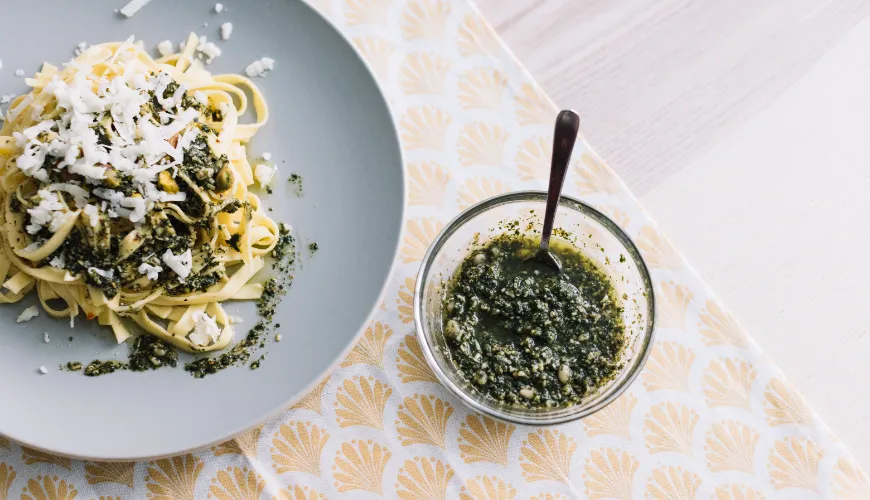
Homemade pesto brings the taste of Italy to your kitchen

Homemade Pesto - The Secret of Fresh Herbs and Intense Flavor
Homemade pesto is not only a quick way to enrich everyday dishes with a strong flavor, but also a culinary experience that allows you to experiment with various ingredients. Whether you prefer traditional basil pesto or venture to try less known variants, homemade pesto can easily become an indispensable part of your kitchen.
Why Make Homemade Pesto?
Making homemade pesto is not just about better taste, but also about control over the quality of ingredients. Store-bought pesto often contains added preservatives, stabilizers, or cheaper alternatives to some ingredients, which can negatively affect its taste and nutritional value. Homemade pesto allows you to use fresh ingredients, tailor the recipe to your preferences, and create a sauce without unnecessary artificial additives.
Another benefit is variability. While traditional basil pesto is a popular choice, there are many ways to adjust it according to available ingredients or seasonal herbs. Moreover, its use in the kitchen goes far beyond pasta – homemade pesto can also be used as a marinade, spread, or part of various sauces.
How Did Pesto Originate? A Brief Historical Insight
The word "pesto" comes from the Italian "pestare," which means to crush or pound. Pesto alla genovese, or traditional basil pesto, originates from Liguria, where it was originally prepared in a mortar to preserve the delicate structure of the ingredients and the intense flavor of the herbs. The original recipe includes basil, pine nuts, garlic, parmesan, olive oil, and salt.
Today, there are other popular variants, such as pesto rosso from sun-dried tomatoes or Sicilian pesto with ricotta. However, Italian cuisine is not the only one inspired by this tasty sauce – similar mixtures can also be found in other world cuisines, such as French pistou or Mexican salsa verde.
Traditional Recipe for Homemade Pesto
The foundation of any good pesto is a combination of quality ingredients. Fresh herbs, top-quality olive oil, and quality cheese are the keys to achieving full flavor. Traditional pesto alla genovese consists of:
- Basil – ideally freshly picked for its fresh aroma and delicate structure.
- Pine nuts – they give the pesto a smooth buttery taste and a slightly sweet undertone. They can be replaced with walnuts or almonds.
- Garlic – for typical spiciness and aromatic depth.
- Parmesan (or pecorino) – provides saltiness and rich texture to the pesto.
- Olive oil – quality extra virgin oil is essential as it binds the flavors and ensures a smooth consistency.
- A pinch of salt – enhances all flavors and helps balance the sauce.
When making homemade pesto, it's worth using a mortar, even though a blender is a more convenient option. Using a mortar gradually releases the aromatic substances from the basil, leading to a more intense flavor. If using a blender, it's good to process the ingredients in pulses and not overheat them to maintain their freshness.
Variations of Homemade Pesto
Homemade pesto can easily be adapted according to available ingredients or personal tastes. Besides the classic basil pesto, you can also try less traditional versions:
- Arugula Pesto – has a more pronounced and slightly peppery flavor. It pairs well with fish or as a salad dressing.
- Parsley Pesto – is milder, refreshing, and complements grilled meats well.
- Sun-Dried Tomato Pesto – adds a sweeter and deeper flavor to dishes, perfect for pasta and bruschetta.
- Spinach Pesto – gentle and fresh, an ideal variant for those who prefer a pesto with a lower intensity of flavor.
- Wild Garlic Pesto – a popular spring variant with a spicy taste.
How to Use Homemade Pesto in the Kitchen?
Pesto is most commonly associated with pasta, but its use is much broader. You can add it to soups, use it as a meat marinade, or mix it into yogurt or sour cream to create a delicious dip. It also works great on pizza instead of tomato sauce or as a spread on fresh bread.
Another interesting option is to mix homemade pesto with ricotta to create a light creamy dip. It also tastes great with roasted vegetables or as part of sandwiches.
Tips for Storing Homemade Pesto
Homemade pesto is a simple and tasty way to enrich various dishes with fresh and intense flavors. Thanks to easy preparation and the ability to adjust ingredients according to personal preferences, it becomes an indispensable part of the kitchen. Whether you choose traditional basil pesto or experiment with other herbs and nuts, you will always get a delicious sauce full of natural flavors.
Homemade pesto can be used not only for pasta but also as a marinade, spread, or part of various dips, giving dishes an original character. Storing is also simple – it lasts several days in the fridge, and even months in the freezer, so you can enjoy its freshness anytime.
Homemade pesto is a great example of how a simple combination of quality ingredients can create an incredibly rich flavor. Its preparation is easy, quick, and allows endless experimentation with flavors. Whether you opt for the traditional recipe or create your own version, homemade pesto will open the door to new culinary experiences.

